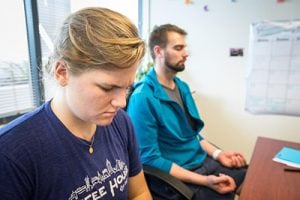/prod01/channel_2/media/mccms/content-assets/about/news/april-2019/MindfulnessGroup16X9.jpg)
November 13, 2018
Of all the things Olivia Thomas expected to study in medical school, walking was not on the list. Yet one recent Tuesday afternoon, Thomas, a second-year medical student at Mayo Clinic Alix School of Medicine in Arizona, found herself in a classroom learning how to put one foot in front of the other — mindfully.
"Think about all the muscles that go into taking each step," instructor Angie Haskovec directed, according to ASU Now. "Notice all the sensations in your feet. The temperature, the texture of the carpet."
The lesson, the publication reports, was part of a four-day course developed especially for Mayo Clinic Alix School of Medicine students by staff at the Center for Mindfulness, Compassion and Resilience at Arizona State University. The goal was to help students learn how a mindfulness practice can help them cope with the challenges they may face in medical school and after graduation, when caring for patients.
"The clinical environment is busy, noisy, full of constant interruptions and distractions," Teri Pipe, Ph.D., chief well-being officer at Arizona State University and founding director of the Center for Mindfulness, Compassion and Resilience, tells us. "There is time-sensitivity, and the stakes are extremely high."
Those conditions can take a toll on providers, and can sometimes lead to burnout or compassion fatigue. Mindfulness can provide an antidote to both.
 "Mindfulness is a skillset that builds focus and attention. Attentive presence can help reduce errors, increase the ability to discern patterns and early warning signs, and support a trusting rapport between patient and physician, which often leads to more accurate diagnosis and treatment," Dr. Pipe says. "Mindfulness practice also has the 'side effect' of reducing some of the stress associated with working in a high pressure environment."
"Mindfulness is a skillset that builds focus and attention. Attentive presence can help reduce errors, increase the ability to discern patterns and early warning signs, and support a trusting rapport between patient and physician, which often leads to more accurate diagnosis and treatment," Dr. Pipe says. "Mindfulness practice also has the 'side effect' of reducing some of the stress associated with working in a high pressure environment."
This story originally appeared in In the Loop, an email newsletter and blog that gives a unique perspective on what’s happening around Mayo Clinic.